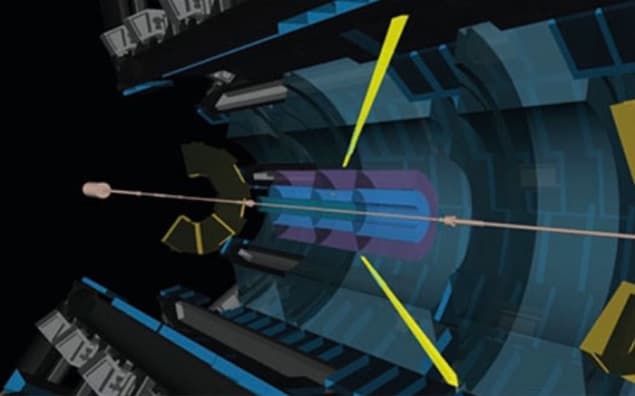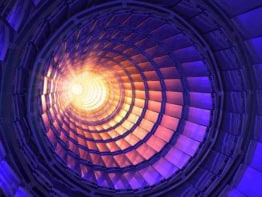
The idea that particles of light can interact with one another – known as light-by-light scattering – has finally been observed some 80 years after it was first predicated. That’s the claim of members of the ATLAS collaboration at CERN in Geneva, who have combed through data they took in 2015 when lead ions collided with each other in their detector. Some scientists, however, dispute the priority of the finding, arguing that light-by-light scattering was observed by an experiment at the SLAC National Accelerator Laboratory in California 20 years ago.
Classically, light cannot interact with light because photons – even though they mediate interactions between charged particles – do not themselves carry charge. However, Heisenberg’s uncertainty principle, a cornerstone of quantum mechanics, says that photons can briefly transform into “virtual” pairs of particles and antiparticles, such as electrons and positrons. There is then a tiny chance that these virtual particles can recombine to create pairs of real photons.
The upshot is that two photons, each producing a virtual particle-antiparticle pair in the process, can scatter off one another. In doing so, they change direction but do not lose any energy. The interaction, in other words, is elastic.
Seeking the light
The idea of looking for this phenomenon at the LHC was put forward in 2012 by CERN’s David d’Enterria and Gustavo Da Silveira, now at the Federal University of Rio Grande do Sul in Brazil. They proposed studying those events in which lead ions do not physically collide with one another but nevertheless pass by close enough that their electromagnetic fields interact a lot. Any light-by-light scattering that does take place would be revealed by two photons flying away from the centre of the detector in opposite directions (to conserve momentum), while the lead ions would continue on an almost undisturbed path around the LHC ring. Technically, those photons, being force mediators rather than particles in a beam of light, are virtual. But because the lead ions travel close to speed of light, the electromagnetic fields associated with them become relativistically compressed. The squeezed field lines at that point therefore resemble a single line, which is characteristic of a real photon. The photons can thus be regarded as “quasi-real”.
Flash of inspiration
Putting the proposal into action, members of the ATLAS collaboration analysed data from lead-ion collisions taking place in their detector during 2015. As they report in Nature Physics, out of a total of four billion events they identified just 13 that could have been due to light-by-light scattering. These were events comprising a single flash of light at two diametrically opposed points in the ATLAS calorimeter, but with no sign of any other particle emission – and in particular no curved tracks from charged particles travelling through the detector’s magnetic field.
The researchers also worked out how many background events would be likely to have produced the same signal during the data-taking period. Such events could include the rare occasions when electrons inside the detector radiate almost all of their energy away in the form of photons. Concluding that the combined background would, on average, yield only 2.6 events, they calculated that their 13 candidate events had a statistical significance of 4.4 standard deviations, just a little short of the 5 standard deviations conventionally required to claim a discovery in particle physics.
Priority claims
Writing a “news and views” piece to accompany the latest paper, Spencer Klein of the Lawrence Berkeley National Laboratory in California points out that ATLAS is not the first experiment to provide evidence of light-by-light scattering. In 1975 physicists in Germany observed photons elastically scattered by the electromagnetic field of a nucleus. However, in that case the photons in the nuclear field were entirely virtual. As such, according to Klein, the ATLAS collaboration “reports the first direct evidence for light scattering from light”.
Adrian Melissinos of the University of Rochester in the US, however, disputes this. In 1997 he was part of a group that published what he regards as direct evidence of light-by-light scattering at the E144 experiment at SLAC. The experiment involved firing photons from an intense laser at high-energy electrons to boost the former to gamma-ray energies, and then recording the few times when those gamma-ray photons interacted with the laser photons.
The experiment was not set up to monitor elastic scattering, but instead detected positrons generated during the inelastic scattering of photons. Nevertheless, Melissinos argues that E144 provided just as direct an observation of light-by-light scattering as has ATLAS. He also points out that the photons in their case, being produced by a laser, were fully real.
Looking ahead
ATLAS should start collecting new data from lead-lead collisions at the end of next year, and should also benefit from an LHC intensity upgrade due for the middle of the next decade. With more statistics, scientists will be more able to work out the contribution of various different charged particles in the scattering process – be they electrons and positrons, muons or even heavier particles from beyond the Standard Model that would signify new physics.
For the moment, however, ATLAS deputy spokesperson Andreas Hoecker is happy simply to have seen the long-predicted effect. “Even without any new physics, light-by-light scattering is already very interesting,” he says. “It is a very beautiful phenomenon.”



